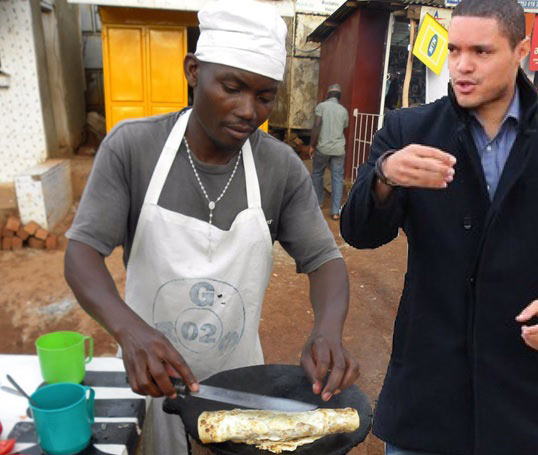Uganda’s vibrant street food scene offers a tantalizing glimpse into the country’s diverse culinary heritage. From bustling urban centers like Kampala to rural roadside stands, street vendors across the “Pearl of Africa” serve up affordable, flavorful dishes that reflect both traditional cooking methods and multicultural influences. These street foods not only satisfy hunger but also provide a genuine connection to Uganda’s food culture and everyday life. Whether you’re navigating the busy streets of Kampala or exploring remote villages, here are the top ten Ugandan street foods that deserve a place on every food lover’s bucket list.
1. Rolex
The Iconic Ugandan Fast Food
 No discussion of Ugandan street food would be complete without mentioning the legendary “Rolex.” Despite its luxurious name, this affordable treat has nothing to do with timepieces—it’s a clever portmanteau of “rolled eggs.” The Rolex has become such a national institution that Uganda even hosts an annual Rolex Festival celebrating this humble street food.
No discussion of Ugandan street food would be complete without mentioning the legendary “Rolex.” Despite its luxurious name, this affordable treat has nothing to do with timepieces—it’s a clever portmanteau of “rolled eggs.” The Rolex has become such a national institution that Uganda even hosts an annual Rolex Festival celebrating this humble street food.
What it is: A Rolex consists of a chapati (flatbread) rolled around a spicy omelet typically filled with diced tomatoes, onions, cabbage, and sometimes peppers. Skilled vendors prepare this treat with remarkable speed, cracking eggs onto sizzling flat pans, chopping vegetables directly into the cooking eggs, and then rolling everything into a freshly made chapati.
Where to find it: Rolex stands are ubiquitous throughout Uganda, especially near transportation hubs, markets, and nightlife areas. The most famous concentration is along “Rolex Row” near Makerere University in Kampala, where students flock for affordable meals.
What makes it special: The perfect Rolex achieves a delicate balance—the chapati remains soft yet sturdy enough to hold the fillings, while the eggs are fully cooked but still moist. Customization options are endless, with adventurous eaters adding everything from avocado to Ugandan beef sausage.
2. Kikomando
 A Filling Combination Named After Commando Forces
A Filling Combination Named After Commando Forces
With a name inspired by military commandos (referencing its “powerful” nature), Kikomando offers perhaps the most caloric value for money in Ugandan street cuisine.
What it is: Kikomando combines chopped chapati with beans, creating a hearty, protein-rich meal. The chapati is cut into bite-sized pieces and mixed with seasoned beans, sometimes topped with a splash of sauce or avocado.
Where to find it: This affordable dish is available at most chapati stands and small local restaurants called “kafundas,” particularly in working-class neighborhoods where laborers seek filling, inexpensive meals.
What makes it special: The contrast between the soft beans and the slightly chewy chapati creates a satisfying texture. The simplicity of Kikomando belies its flavor—the beans are typically slow-cooked with onions, local spices, and sometimes smoked meat, creating a rich taste that pairs perfectly with the neutral chapati.
3. Muchomo
Uganda’s Answer to Barbecue
 Translating roughly to “roasted meat” in Luganda, muchomo represents Uganda’s proud tradition of grilled meats, with techniques passed down through generations.
Translating roughly to “roasted meat” in Luganda, muchomo represents Uganda’s proud tradition of grilled meats, with techniques passed down through generations.
What it is: Muchomo refers to skewered and grilled meats, most commonly goat, beef, chicken, or pork. The meat is typically marinated in a blend of spices, then roasted over open charcoal grills until slightly charred on the outside while remaining juicy within.
Where to find it: Muchomo stands are marked by the distinctive sight of smoking grills, often set up near bars, taxi parks, and busy intersections. The Kabalagala neighborhood in Kampala is particularly known for excellent muchomo, especially in the evening hours.
What makes it special: The art of muchomo lies in the grilling technique and marinade. The best vendors use a special blend of salt, pepper, curry powder, and local herbs. Muchomo is typically served with toothpicks for easy eating and accompanied by kachumbari (a fresh tomato and onion salad) or cassava chips. Some vendors offer a spicy piri-piri sauce on the side for those who enjoy heat.
4. Nsenene (Grasshoppers)
A Seasonal Delicacy
 Perhaps the most distinctive entry on this list, Nsenene represents Uganda’s tradition of seasonal insect consumption—a practice that predates colonial influence and remains popular today.
Perhaps the most distinctive entry on this list, Nsenene represents Uganda’s tradition of seasonal insect consumption—a practice that predates colonial influence and remains popular today.
What it is: Nsenene are long-horned grasshoppers harvested during rainy seasons (typically May and November). The grasshoppers are cleaned, wings and legs removed, then fried with onions and sometimes seasoned with salt or curry powder.
Where to find it: During grasshopper season, vendors appear throughout central Uganda, particularly around Masaka and Kampala. Listen for the distinctive sound of vendors calling “nsenene!” or look for crowds gathered around large pans of the sizzling insects.
What makes it special: With a taste often compared to crispy shrimp, nsenene offer a unique combination of crunchy texture and subtle flavor. They’re also highly nutritious, containing significant protein and essential minerals. The harvesting of nsenene is deeply cultural, with specific techniques passed down through generations. The appearance of nsenene vendors marks a festive atmosphere in Uganda’s streets.
5. Katogo
The Ultimate Breakfast Street Food
 While traditionally a breakfast dish, katogo has found its way to street vendors who serve this hearty meal throughout the day to busy commuters and workers.
While traditionally a breakfast dish, katogo has found its way to street vendors who serve this hearty meal throughout the day to busy commuters and workers.
What it is: Katogo consists of matooke (green cooking bananas) mixed with various accompaniments such as offal (especially beef tripe), beans, or groundnut sauce. The ingredients are slow-cooked together until the flavors meld into a rich, satisfying stew.
Where to find it: Morning markets and areas around bus and taxi parks often feature katogo vendors, identifiable by their large cooking pots and the distinctive aroma of the dish. Many small roadside restaurants also serve katogo throughout the day.
What makes it special: Katogo embodies Ugandan comfort food at its finest. The matooke provides a subtle sweetness that balances perfectly with the savory accompaniments. Street vendors often develop loyal followings based on their specific katogo recipe and cooking technique.
6. Chapati
The Versatile Flatbread with East African Flair
 While chapati appears as a component in several items on this list, it deserves recognition as a standalone street food that Ugandans have adapted from Indian culinary traditions.
While chapati appears as a component in several items on this list, it deserves recognition as a standalone street food that Ugandans have adapted from Indian culinary traditions.
What it is: Ugandan chapati differs slightly from its Indian counterpart, typically being slightly thicker and often incorporating a spiral folding technique during preparation. Made from wheat flour, water, and oil, these flatbreads are cooked on a hot griddle until golden brown with characteristic dark spots.
Where to find it: Chapati stands are among the most common street food vendors in Uganda, operating from simple wooden carts equipped with a flat cooking surface. They’re particularly concentrated around transportation hubs, markets, and residential areas.
What makes it special: The preparation of chapati is a performance in itself—vendors skillfully roll the dough, create the spiral pattern, flatten it again, and cook it to perfection while chatting with customers. Fresh chapati has an irresistible aroma and can be eaten plain, used to scoop up stews, or incorporated into other dishes. Some vendors add a unique twist by incorporating grated carrots or onions into the dough.
7. Gonja (Roasted Plantains)
Nature’s Sweet Treat
 Simple yet delicious, gonja represents street food in its most elemental form—minimal ingredients transformed through traditional cooking methods.
Simple yet delicious, gonja represents street food in its most elemental form—minimal ingredients transformed through traditional cooking methods.
What it is: Gonja are ripe plantains roasted in their peels over charcoal until the skin blackens and the fruit inside becomes soft and caramelized. Once cooked, the charred skin is partially opened, revealing the sweet, smoky flesh inside.
Where to find it: Gonja vendors are easily spotted by their distinctive setup—a small charcoal stove or metal drum with plantains roasting directly on the coals. They’re common at roadsides, market entrances, and near busy pedestrian areas.
What makes it special: The slow roasting process caramelizes the plantain’s natural sugars, creating a complex sweetness enhanced by subtle smoky notes from the charcoal. Unlike many street foods that incorporate multiple ingredients, gonja showcases the pure flavor of a single ingredient transformed by fire. It’s commonly enjoyed as an afternoon snack or dessert.
8. Kikalayi Chicken
Urban Street Barbecue
 Named after the large, circular metal pans (kikalayi) used for cooking, this dish represents Uganda’s creative adaptation of grilled chicken with distinctly local preparation methods.
Named after the large, circular metal pans (kikalayi) used for cooking, this dish represents Uganda’s creative adaptation of grilled chicken with distinctly local preparation methods.
What it is: Kikalayi chicken consists of chicken parts grilled on flat metal pans over charcoal. The chicken is typically seasoned with salt, curry powder, and sometimes garlic and ginger, then cooked until the skin is crispy while the meat remains juicy.
Where to find it: Kikalayi vendors operate in evening markets, near bars, and in busy commercial areas of towns and cities. In Kampala, areas like Wandegeya and Kabalagala are known for excellent kikalayi chicken.
What makes it special: The cooking method allows the chicken to cook in its own rendered fat, creating a self-basting effect. Vendors often develop their own signature spice blends, creating loyal customer bases who return for their particular flavor profile. Kikalayi chicken is typically served with kachumbari (tomato and onion salad) and sometimes cassava chips.
9. Mandazi
Sweet Breakfast Pastry with Coastal Influences
 Reflecting East Africa’s coastal connections, mandazi represents the sweeter side of Uganda’s street food landscape.
Reflecting East Africa’s coastal connections, mandazi represents the sweeter side of Uganda’s street food landscape.
What it is: These triangular or square-shaped fried dough pastries resemble unsweetened donuts in texture. Made from a simple dough of flour, water, sugar, and sometimes flavored with cardamom or coconut milk, mandazi are deep-fried until golden and puffy.
Where to find it: Morning markets, school areas, and transportation hubs typically feature mandazi vendors. The pastries are often displayed in large baskets or clear containers, sold individually or in small batches.
What makes it special: The perfect mandazi achieves a delicate balance—crisp exterior giving way to a soft, slightly chewy interior. Unlike Western donuts, mandazi are only lightly sweetened, making them versatile enough to pair with savory dishes or enjoy with sweet chai tea. Some vendors incorporate local innovations like mashed ripe bananas into the dough for added flavor and moisture.
10. Samosas
The Triangular Flavor Packets
 Adapted from Indian cuisine during colonial times, Ugandan samosas have evolved into a distinctly local street food with unique flavors and preparation methods.
Adapted from Indian cuisine during colonial times, Ugandan samosas have evolved into a distinctly local street food with unique flavors and preparation methods.
What it is: Triangular pastries filled with spiced meat (typically beef or chicken) or vegetables, then deep-fried until crisp and golden. Ugandan samosas tend to be smaller than their Indian counterparts and often feature a blend of Indian and local spices.
Where to find it: Samosa vendors are common near office buildings, schools, taxi parks, and markets. Look for the distinctive glass cases protecting stacks of these golden triangles, often accompanied by chili sauce for dipping.
What makes it special: Ugandan samosas typically feature a thinner, crispier pastry shell than Indian versions, with fillings that often incorporate local ingredients like cabbage, carrots, and green peppers alongside the traditional onions and spices. The best vendors achieve the perfect balance between the crisp exterior and flavorful, moist filling.
11. Roasted Cassava
The Hearty Root Vegetable Snack
 A staple food throughout Uganda, roasted cassava represents the country’s agricultural heritage and the ingenious simplicity of traditional cooking methods.
A staple food throughout Uganda, roasted cassava represents the country’s agricultural heritage and the ingenious simplicity of traditional cooking methods.
What it is: Fresh cassava roots are peeled, cut into manageable pieces, and slow-roasted over charcoal until the exterior develops a slight char while the interior becomes tender and fluffy. The result is a starchy, slightly sweet snack that’s both filling and satisfying.
Where to find it: Cassava vendors are particularly common along highways, at rural trading centers, and near busy transportation hubs. Look for vendors with small charcoal stoves and cassava roots displayed on wooden tables or in baskets. In Kampala, areas like Nakawa and Natete markets offer excellent roasted cassava.
What makes it special: The slow roasting process transforms the sometimes bland cassava into a complex treat with caramelized notes and smoky undertones. The best vendors know precisely how long to roast the cassava—too little and it remains tough; too much and it becomes dry. When perfectly cooked, roasted cassava offers a crisp exterior giving way to a soft, starchy interior with a subtle sweetness.
Vendors often serve roasted cassava with accompaniments that create a perfect flavor balance: a sprinkle of salt, a side of pili-pili (chili sauce), or kachumbari (tomato and onion salad). Some vendors offer small packets of groundnut (peanut) sauce for dipping, creating a protein-rich snack that sustains many Ugandans through long work days.
What makes roasted cassava particularly significant is its deep connection to Uganda’s agricultural practices—cassava grows abundantly even in challenging conditions, providing food security across the country. The simple act of roasting this humble root vegetable represents the resourcefulness and practical ingenuity that characterizes much of Ugandan cuisine.
Conclusion: Embracing Uganda’s Street Food Culture
Uganda’s street food scene offers a delicious lens through which to understand the country’s cultural diversity, colonial history, and culinary creativity. From the nationally beloved Rolex to seasonal delicacies like nsenene, these foods tell the story of Uganda’s people—resourceful, adaptable, and skilled at creating memorable flavors from simple ingredients.
When sampling street foods in Uganda, observe local practices regarding food safety—generally, busy stalls with high turnover and food cooked fresh in front of you offer the safest options. Don’t hesitate to engage with vendors, who often take enormous pride in their craft and appreciate genuine interest in their cooking.
Beyond mere sustenance, these street foods facilitate social connection—gathered around a muchomo grill or waiting for a freshly made Rolex creates spaces for conversation and community. For visitors and locals alike, Uganda’s street food offers not just a taste of the country’s culinary traditions but a gateway to understanding its vibrant culture.
Come experience Uganda’s street food culture on a self drive or drive-guided tour in Kampala city so you can get a full-feel of these tasty delicacies readily available on every street in Kampala city and popular long-distance routes. Contact us today by sending an email to info@ugandacarrentalservices.com or call us now on +256-700135510 to speak with the reservations team.










Related Articles
Self-Drive to Bwindi National Park: A Comprehensive Guide
Top 12 Uganda Car Rental Hidden Costs to Watch Out For
Essential Maintenance Practices For Self Drive In Uganda